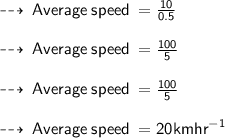Explanation:
An object which moves 10 km in 30 minutes .
we have to find the average speed of the object .
Changing unit of time into hour
Time = 30/60 hour
Time = 1/2 hour
Time = 0.5 hour
Now let's calculate the average speed

Put the value we get

So, the average speed is 20km/hr